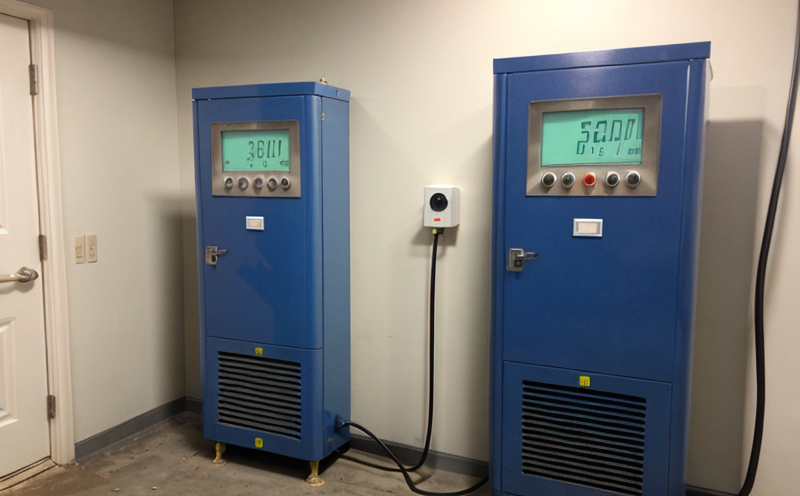DIN 51855 Mine Atmosphere Sampling and Analysis Testing
The DIN 51855 standard specifies methods for sampling and analyzing mine atmospheres to ensure the safety of workers in underground mining operations. This method is essential for maintaining a safe working environment by detecting potentially hazardous gases, dusts, and other contaminants that can affect worker health and safety.
The testing procedure outlined in DIN 51855 involves several critical steps: sample collection, transportation to the laboratory, analysis using appropriate instrumentation, and interpretation of results. The standard ensures that all aspects of sampling are conducted rigorously to avoid contamination or loss of integrity during transit. Proper sampling techniques are crucial as they directly influence the accuracy of subsequent analyses.
Sampling is typically performed at various points within the mine shafts to capture representative samples of ambient air. Instruments used for this purpose include hand-operated samplers, automated sampling systems, and portable gas analyzers. These tools must be calibrated regularly according to ISO 17025 standards to ensure reliable readings.
Once collected, samples are transported under controlled conditions to the laboratory where they undergo detailed analysis using advanced analytical techniques such as gas chromatography (GC), Fourier Transform Infrared Spectroscopy (FTIR), and other specialized methods. The choice of technique depends on the specific contaminants being targeted for measurement.
The primary goal of DIN 51855 testing is to provide accurate, reliable data about mine atmosphere conditions so that appropriate measures can be taken to mitigate risks associated with exposure to harmful substances. By adhering strictly to the prescribed procedures outlined in this standard, laboratories ensure consistent and repeatable results across different mines and operations.
It's important to note that compliance with DIN 51855 is not just about meeting regulatory requirements; it also plays a vital role in enhancing overall occupational safety within mining industries worldwide. Regular testing helps identify problem areas early on, allowing management teams time to implement corrective actions before incidents occur.
Benefits
Implementing DIN 51855 mine atmosphere sampling and analysis offers numerous benefits that contribute significantly towards improving occupational safety in the mining sector. One key advantage is enhanced worker protection since continuous monitoring allows for early detection of hazardous conditions, enabling timely interventions.
Another benefit pertains to improved operational efficiency as managers gain valuable insights into ventilation patterns throughout their facilities. This knowledge can help optimize airflow systems and reduce energy consumption without compromising air quality standards. Additionally, compliance with international standards like DIN 51855 enhances reputation among stakeholders by demonstrating commitment to best practices in safety management.
Furthermore, such testing contributes positively towards environmental sustainability efforts by promoting responsible use of resources while minimizing waste generation during operations. Lastly, it supports continuous improvement initiatives aimed at reducing incidents related to poor air quality within mines.
Environmental and Sustainability Contributions
DIN 51855 plays a crucial role in supporting environmental sustainability goals by ensuring that mining activities are conducted safely and responsibly. By adhering to this standard, companies demonstrate their commitment to protecting both human health and the environment.
The testing process outlined in DIN 51855 helps minimize occupational risks associated with exposure to harmful substances present in mine atmospheres. This reduces the incidence of work-related illnesses among miners, thereby contributing positively towards public health outcomes. Moreover, regular sampling and analysis enable mines to identify potential sources of contamination promptly, facilitating prompt corrective actions.
From an environmental perspective, compliance with DIN 51855 fosters responsible resource management practices by helping companies understand how their operations impact local ecosystems. This awareness encourages adoption of more sustainable approaches that balance economic growth with ecological preservation.
Use Cases and Application Examples
| Use Case | Description |
|---|---|
| Monitoring Methane Levels | Detecting methane levels in mine atmospheres is critical for preventing explosions. DIN 51855 provides standardized procedures for collecting and analyzing samples to ensure accurate measurements. |
| Evaluating Carbon Monoxide Exposure Risks | Carbon monoxide poisoning remains a significant risk factor among underground miners. Regular sampling according to DIN 51855 guidelines helps monitor exposure levels effectively. |
| Assessing Dust Particulate Concentrations | Dust particles pose serious respiratory hazards; therefore, continuous monitoring through DIN 51855-compliant methods is necessary for maintaining safe working conditions. |
| Analyzing Silica Content in Air Samples | Silica exposure is linked to silicosis—a debilitating lung disease. Proper sampling and analysis according to DIN 51855 specifications help manage this risk effectively. |
| Identifying Hydrogen Sulfide Presence | Hydrogen sulfide can cause severe health issues when present in high concentrations. DIN 51855 supports the detection of these levels accurately using appropriate analytical techniques. |
| Determining Nitrogen Oxides Emissions | Nitrogen oxides contribute to air pollution and pose respiratory risks; regular sampling per DIN 51855 ensures compliance with emission limits. |
| Measuring Volatile Organic Compounds (VOCs) | VOCs are known carcinogens; their presence in mine atmospheres should be monitored closely. DIN 51855 offers robust protocols for this purpose. |
| Evaluating Radon Levels | Radon is a radioactive gas that can increase cancer risks if exposed over extended periods. Continuous monitoring through DIN 51855 helps manage this risk effectively. |





